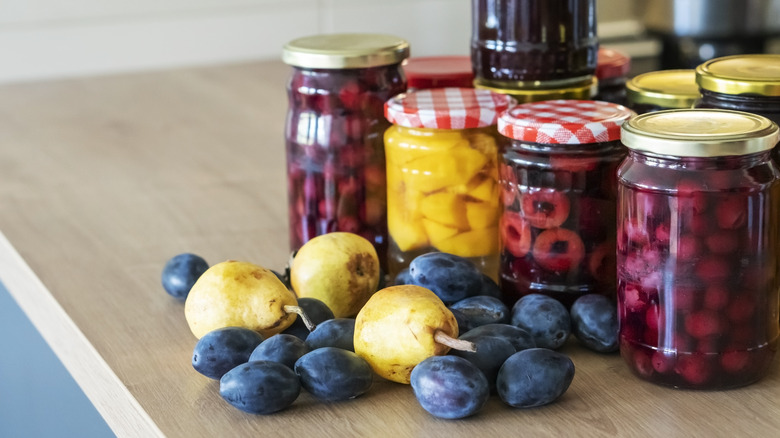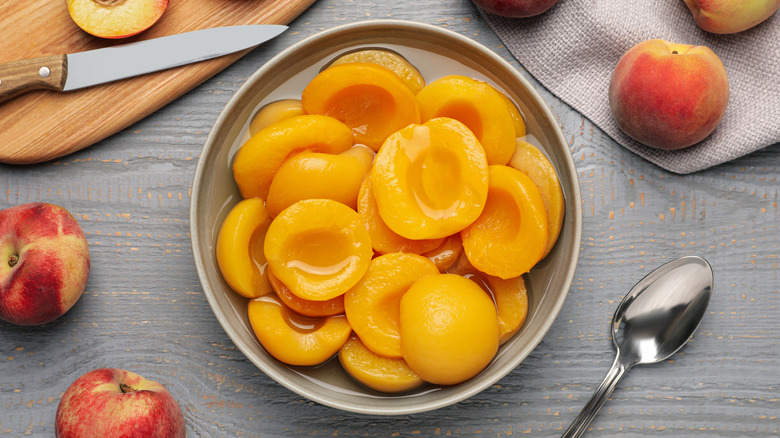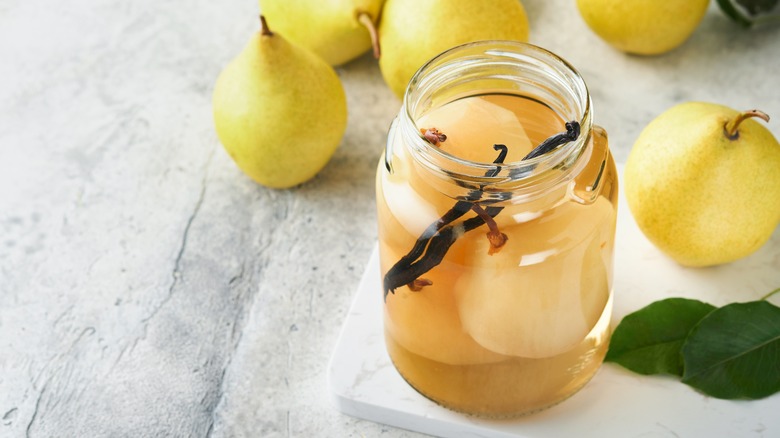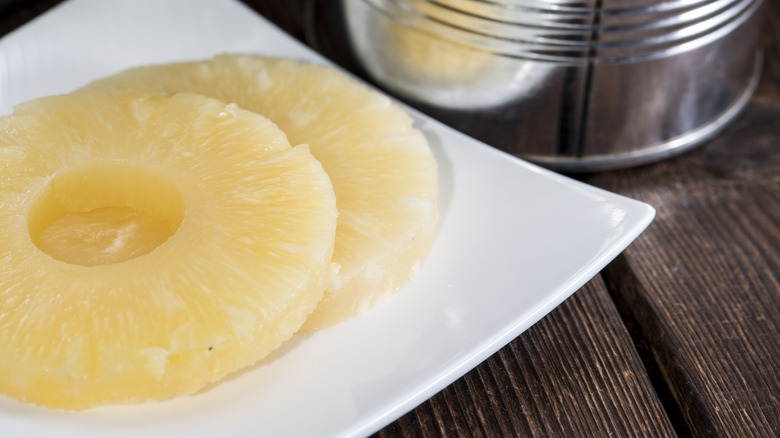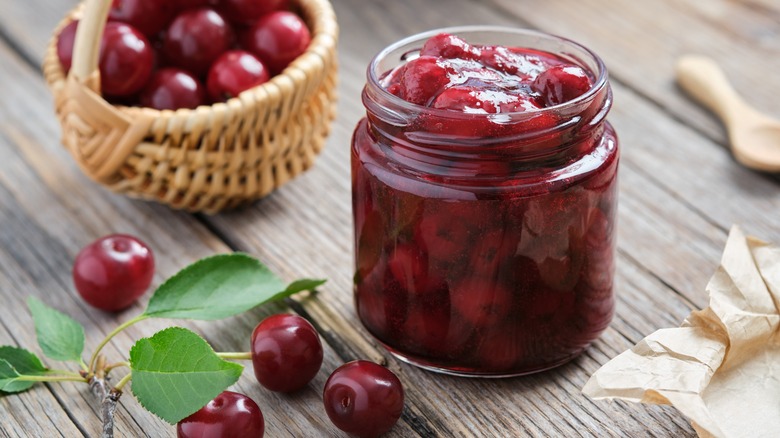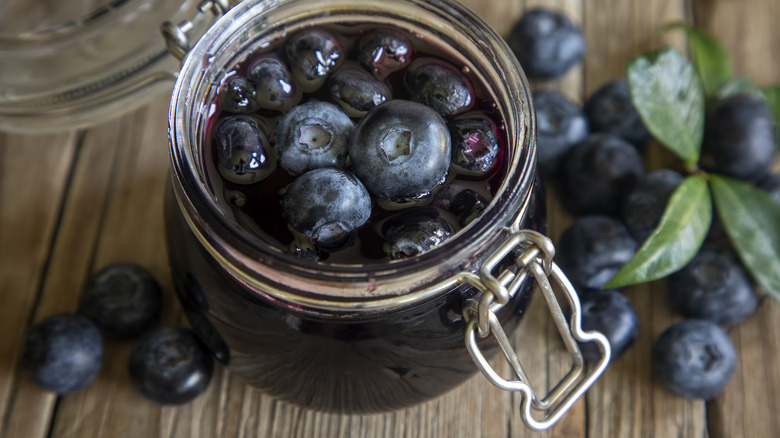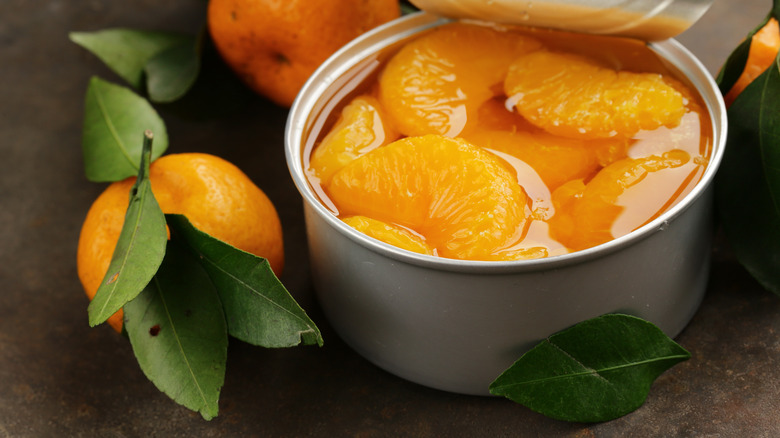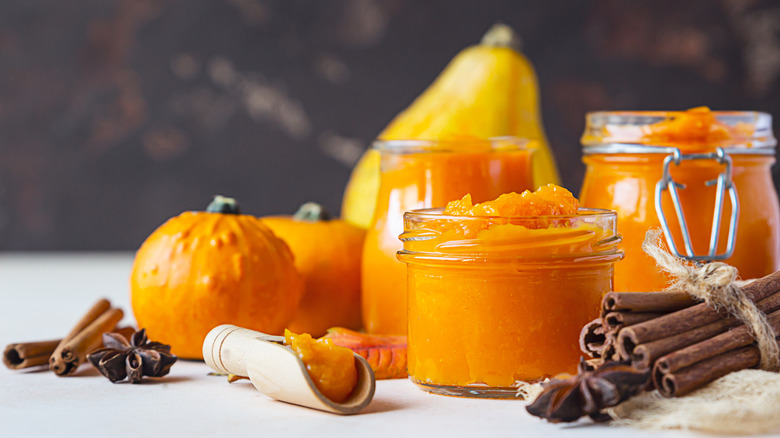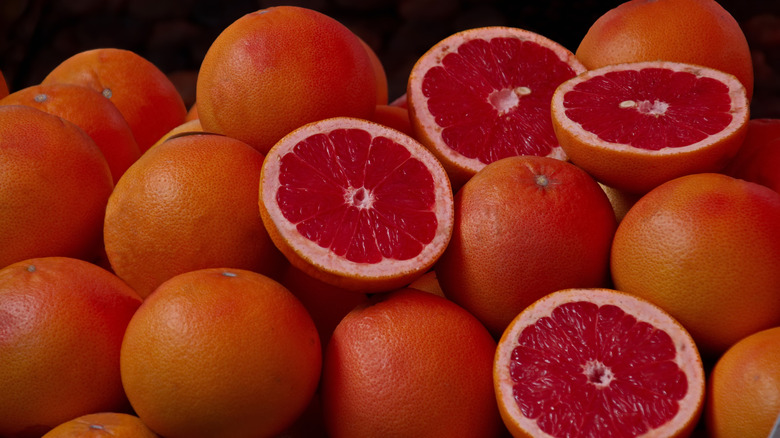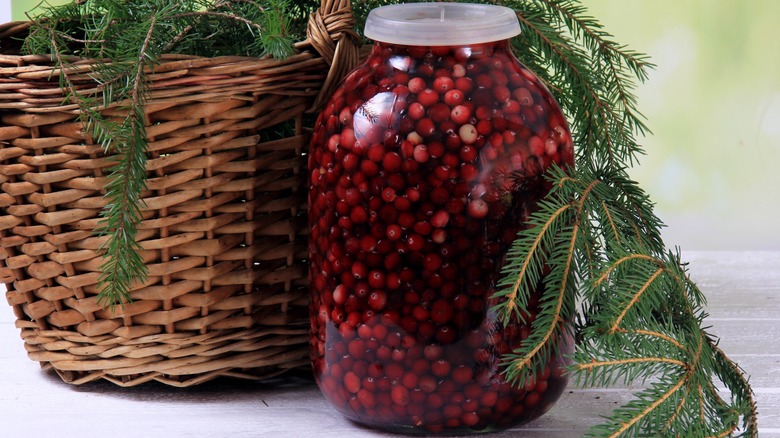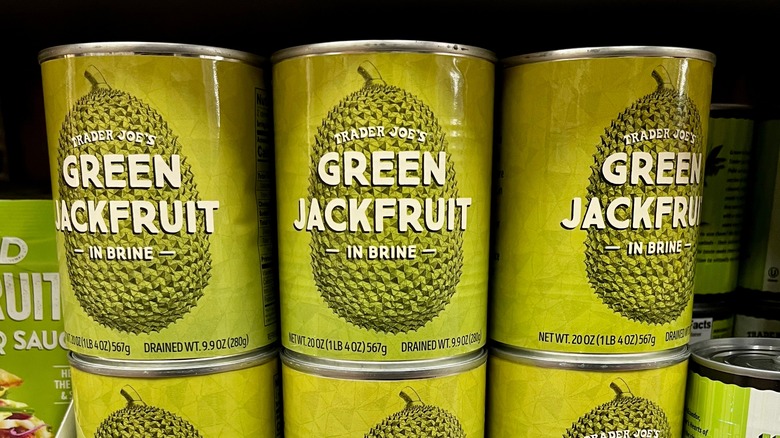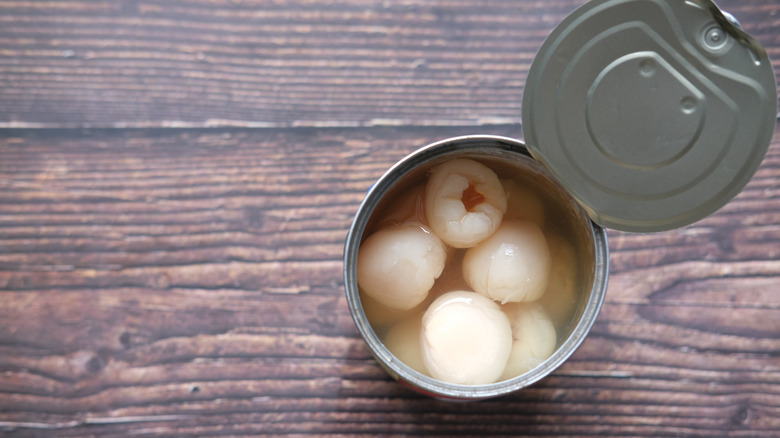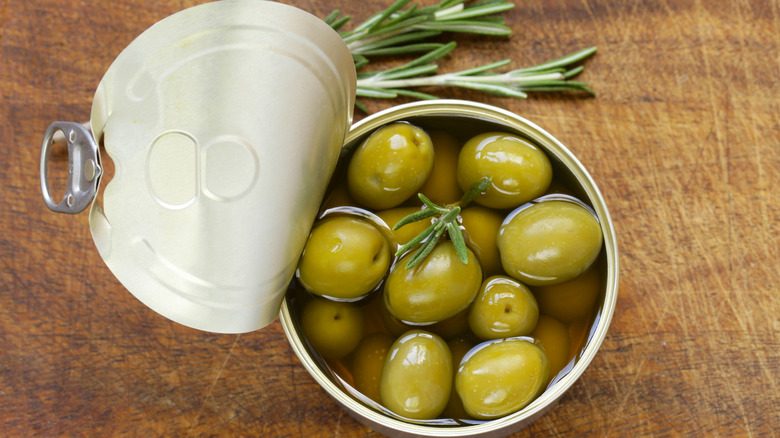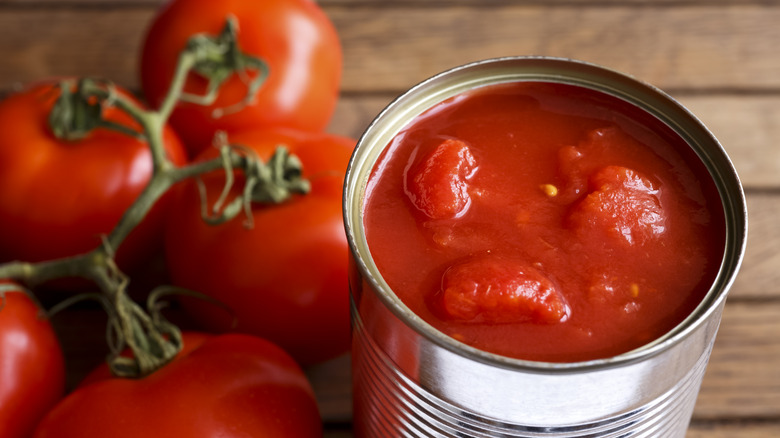13 Canned Fruits You Should Consider Stocking In Your Pantry
Since time immemorial, humanity has been beset by a love of fruit alongside the bitter knowledge that seasonal fruits come and go seemingly in the blink of an eye. Fortunately, back in the early 1800s, French confectioner Nicolas Appert came up with a handy process called "canning" that could keep the stuff on the shelves for a lot longer than it could otherwise last. The rest, as they say, is history. Regardless of whether you can buy it yourself at home or in steel cans from your local grocery store, canned fruit is a staple of many pantries.
While some worry about the canning process zapping a fruit's nutritional value, the loss of some vitamins doesn't mean that canned fruit is without nourishment. Rather, the fruit chosen for canning tends to represent the best of their respective crop and generally retains roughly the same nutrients as fresh produce. This has helped its reputation as a cheap, affordable, and, yes, healthy snack. Still, there's so much more to canned fruit than the basic vitamins we get from them, and they are always a good addition to the pantry due to both their longevity and versatility. While fresh fruit is a wonderful seasonal treat, canned fruit is easily available all year long, so it's good to stock a variety.
Peaches
If there is an MVP of canned fruits, it may very well be the mighty peach. Fresh peaches are a delight, but they come with a number of downsides. They can be a bit of a struggle to eat, with the fuzzy skin not always to everyone's preference and the fruit itself easily becoming bruised under relatively light stress. For anyone who has struggled with fresh peaches, the canned route may be the one for you. Not only are canned peaches easily found at almost any grocery store, but there are several recipes for them that you may not yet have discovered.
Peaches are commonly used for baked desserts, such as canned fruit cobbler or streusel cake. Peaches and cream oatmeal are a classic breakfast staple, while some opt to eat the canned treat alongside cottage cheese for an offbeat snack. They can be used alongside pork in BBQ entrees or tossed into a healthy morning smoothie to get you going. The possibilities are limitless, but even if all you've got is a can opener and a dream, peaches right out of the container will make for a tasty treat to tide you over until dinnertime.
Pears
Alongside peaches, pears are one of the more consistently available canned fruits, and they can be used in just about anything you would put peaches in. This makes them not just a solid pantry item to keep around in their own right but also a possible fill-in should you run out of other canned fruits. Pears have a subtly sweet depth that sometimes goes unappreciated, but its adaptability is where it really shines. Keep them in your cupboard for a rainy day, and they'll always be ready should the inspiration strike to expand your pear-based recipes.
The somewhat neutral citrus overtones of pears combine exceptionally well with spicier ingredients such as chai, and the two complement each other nicely in smoothies. Pear berry salsa is an interesting alternative to dip into if you're looking to go a step beyond your standard pico de gallo mix. If you're open to inventive pizza toppings, you might feel brave enough to try out a BBQ pizza with roasted pears on top. At this point, chefs have put canned pears into everything from breakfast hash to spring rolls, so it can't hurt to stock a few extra cans on your next trip to the grocery store.
Pineapples
Chances are you're already set firmly in place on whether or not you think canned pineapple belongs on a pizza, but that's far from the only use for this South American native fruit. Despite its association with Hawai'i due to the now-defunct pineapple plantation of James Dole (now a tourist destination), most of the world's pineapple is grown in Costa Rica. In the early days, pineapples were processed before shipments to avoid spoilage, making this a fruit in which canning plays a surprisingly vital historical role. As such, plenty of people around the world may only ever eat pineapple that comes from a can, so it may go without saying that many of the recipes requiring pineapple are very can-friendly.
Like many of the fruits on this list, pineapple can be magic for sweets, adding an extra kick to an already decadent after-dinner snack. They are tangier than pears and peaches and go particularly well in breakfast treats like muffins or baked oatmeal. Alongside being a controversial celebrity in the world of pizza toppings, they can add a similarly distinct flavor to dishes like fried rice or stir fry. Then, of course, there is pineapple upside-down cake, an easy-to-make dessert that is destined to impress as an after-dinner bite.
Cherries
Cherries originally hail from Asia Minor and are believed to have been brought to Europe via bird migration, which is a pretty neat origin story for a fruit that currently grows just about everywhere that climate allows. Recorded history featuring cherries dates back to 72 B.C., and today the world produces more than 650 tons of cherries every year. You may have only tried a few kinds of cherries in your life, but there are more than 1,000 different varieties grown in the U.S. alone. Canned cherries can cover a lot of ground when it comes to specific taste profiles, but they're known for their tart taste, which works excellently in tandem with the sweet, flakey crust of a cherry pie.
Indeed, cherries are perhaps best known for their ability to complement desserts, making them a go-to for cheesecakes, cobblers, pies, and cakes. Cocktail cherries have a proud place in the realm of adult beverages as well, working as a garnish for everything from old fashioned to bourbon bombs. A lot of drinks that don't include cherries in the recipe can be modified slightly to add them, leaving the door wide open for experimental concoctions. Adding cherries to gin and tonics, whiskey sours, margaritas, and manhattans can create what feels like a completely different drink from the originals, so any mixologist will likely have jars of cherries on the shelf.
Blueberries
Blueberries are one of the easiest berries to grow from scratch, making them a popular choice for gardeners everywhere. As a single blueberry bush can potentially produce up to 6,000 blueberries a year, strategically placing one of these perennial shrubs in your garden could be a lucrative move. They are Canada's most exported fruit, but you can find these "star fruits" just about anywhere. The health benefits of these small but mighty berries are many, including being high in phytochemicals, vitamins, and fiber. Considering how many blueberries come from a single bush, figuring out what to do with them all at the end of the season naturally leads to canning.
This fruit is commonly used for jams, preserves, and pie fillings that can be easily purchased in the baked goods section of stores. On the other hand, due to their ubiquitous nature, many people simply can them at home with a pressure cooker or boiling water bath. However you get your canned blueberries, there are plenty of uses, from blueberry-infused syrups to easily prepared breakfast items like overnight oats. One of the best-known uses for canned blueberries is as a topping for pancakes, be that in the form of syrup or sauce.
Mandarin oranges
Most canned mandarins are satsuma mandarins, which are easily bruised during shipping and have only had a chance to reach such heights of global popularity through the magic of canning. Small and seedless, they make for excellent healthy snack foods with a lengthy shelf life, which might be why a lot of kids across the U.S. regularly find them packed into lunches. Many experts advise parents to incorporate them into their children's meals as early as nine months of age due to their substantial health benefits, and the fine art of canning has made them widely available just about anywhere you get your groceries.
Mandarin oranges also work exceptionally well in smoothies, and adding a little banana, flaxseed, and milk can exceed your daily recommended dosage of fruit in a single drink. Similarly, they can make for a great addition to salads, pairing well with greens of any kind as well as other popular toppings like cranberries, pecans, or sunflower seeds. This is another canned fruit that has made some surprising appearances in recipe books, be that via salsas or as a pizza topping. Still, if you want to keep it simple, they are well-suited to be a mid-day snack, offering a healthy alternative to chips or pastries.
Pumpkin
As with blueberries, pumpkin is a fruit that you can find just about everywhere, but roughly 95% of those used in production are grown in Illinois. Each fall, there is an overabundance of these gourds, with pumpkin-flavored everything gracing restaurant menus and pumpkin carving, leaving us with the challenge of figuring out what to do with all those seeds. Known for their association with autumn and, in particular, Halloween, the nutritional value of pumpkins can sometimes fall by the wayside, but it's one of this fruit's strongest features. Featuring vitamins like A, C, and E and minerals like iron and potassium, pumpkin is often recommended for humans and animals alike (it can be mixed in with dog food for a healthier diet).
Canning pumpkin ensures that they don't have to be restricted to the late months of the year. Not only can you enjoy pumpkin-themed desserts all year round, you can also reap the nutritional benefits by incorporating sugar-free canned pumpkin into simple homemade face masks, sugar scrubs, or lip balms. Pumpkin spice lattes often utilize artificial flavoring to get their taste, but you can easily make them at home with a bit of puree. Why coffee and pumpkin complement each other so well we may never know, but we might as well kick back and enjoy it.
Grapefruit
Grapefruit can be a fairly contentious fruit, as the slightly bitter taste that makes them relatively unpopular has long fought it out against the incredible nutritional value that makes them such an essential part of many diets. Some eat grapefruit with salt to make them a bit more palatable, while many others juice them to add to smoothies or other drinks, and others still simply like the unique flavor of grapefruits on their own. Canning methods are historically how we prevent large-scale waste with these seasonal fruits, so they're another item on this list that benefits greatly from the process.
Wherever you fall on the grapefruit scale, you can easily make good use of them in any number of recipes. Canned grapefruit may not be quite as readily available as its more popular shelf-mates like peaches and pears, but that's all the more reason to keep them around in case the need for them arises. Grapefruit works very well in cocktails, with the slightly bitter, slightly sweet flavor of alcohol matching the similar taste of the fruit. Like mandarin oranges, canned grapefruit are good salad topping as well, granting your greens a more subdued taste than the strong citrus of oranges.
Cranberries
Native to North America, most cranberries are grown in Wisconsin or Massachusetts. They might be most famous as the sauce you see served alongside a Thanksgiving turkey but limiting them to that single use would be a mistake. Indeed, canned cranberries regularly appear as a sauce, but you can easily find whole cranberries as well, and that might be the more versatile form. Adding them to desserts is an obvious recipe for success, and they are well-loved ingredients in muffins, oatmeal, cookies, granola, and pies.
Cranberries are rich in antioxidants and are believed to play a role in protecting against UTIs, stomach problems, and even cancer, so they're good to keep around, even if only for health purposes. Still, their unique tart flavor makes them a difficult profile to reproduce via substitutes, so it's always good to have them around for recipes. As with many canned fruit, there are some uses for cranberries that may surprise you, such as a garnish for sweet potatoes or a major ingredient in vegan and vegetarian casseroles. If all else fails, you can always add them to smoothies and reap the health benefits while mixing them with more subtle fruits like bananas.
Jackfruit
Hailing from Southeast Asia, canned jackfruit has only recently risen in popularity in the U.S., with vegans and vegetarians regularly using its malleable profile as a basis for recipes ranging from tacos to BBQ sandwiches. These can be pretty unwieldy fruit in its fresh, whole form, clocking in at as much as forty pounds. This makes it fairly understandable as to why you usually only see them in a can and perhaps why it took so long for Americans to get wise to the many different uses for jackfruit. Now that the cat is out of the bag, this is something you'll want to keep stocked because you never know when you'll need a can of jackfruit.
You can buy canned jackfruit both unripe, where it is used as a vegetable, or ripe, which is sweeter and tastes like a combination of banana and pineapple. Due to being canned in brine, it's good to rinse jackfruit before using it, but after that, the sky is the limit. Much like with tofu, taking extra time to marinate and season unripe jackfruit can work wonders for how they end up tasting at the end of the day, so be sure to do a little research on how to eat them before just popping open the can and hoping for the best. That said, they are especially useful as a meat substitute and can be prepared as fried "chicken" drumsticks, "tuna" salad, and BBQ "ribs," among other possibilities. For ripe jackfruit, you can use them in desserts or eat them right out of the can.
Lychees
Lychee is native to South China, Malaysia, and North Vietnam, so it's through canning that they have become as well-known worldwide as they are today. Relatively low in fiber, they make up for it with high quantities of Vitamin C, potassium, and copper, so their health benefits are nothing to scoff at. As for their taste, they are a nuanced fruit, similar to strawberry or watermelon, but ultimately defined by their individual characteristics. Perhaps less well-known than many of the other fruit on this list, lychee is an underdog worth the time to get to know a little better.
These fruits are particularly recognized for their many uses in alcoholic beverages as either a garnish or a flavoring, with canned lychee perfectly complementing drinks like martinis and coladas. Yet, that's far from their only use, as they work well in desserts as well as more savory dinnertime recipes. Adding them to classics like duck curry, fried rice, and chicken stir fry is a great way to appreciate the subdued flavor they bring. Lychee jelly and cake are popular dessert items, but they're also tasty when added to fruit salad or even incorporated into popsicles for a frozen summertime treat.
Olives
Olives are classically found in the Mediterranean Basin but were brought to North America by Spanish colonists in the late 1700s. As such, the black canned olives that you see in grocery stores are actually native to Mexico and Central America. Today, there are over 130 varieties of olive grown across 23 different countries, meaning that it might take some trial and error to work your way through figuring out which kind you prefer. Fortunately, each olive has a unique use, with green olives associated as a cocktail garnish, while kalamata olives tend to be put in salads and sandwiches.
Naturally, canned black olives are well-known for their prominence as a pizza topping, but they also pop up frequently in salads and pasta. Visiting the olive bar at your local grocery store will inform you how olives can be prepared, with stuffed olives intended as a stand-alone snack while other olives are intended to accompany other ingredients. Olives of all kinds tend to be used more as a garnish than a main character in most recipes, but with that said, they're great to eat right out of the jar, offering up a snack high in antioxidants and healthy fats.
Tomatoes
Perhaps the most widely used of all canned fruit, canned tomatoes are an absolute workhorse that pops up in endless recipes across the internet. It's easier to try and list reasons why you wouldn't keep canned tomatoes on hand than reasons why you would, considering that they are major players in pasta, soups, chilis, pizzas, casseroles, and beyond. Not only are they used in just about everything, there are many different ways to buy canned tomatoes, with whole-peeled bringing a totally different vibe than fire-roasted and pureed, fulfilling functions that crushed could not. Your recipes will likely specify which you should buy, but keeping your pantry stocked with a variety could help you avoid late-night, last-minute grocery runs.
Fresh tomatoes have a notoriously short shelf-life, and you have to act fast to ensure you put them to good use and don't end up creating unnecessary food waste. Likewise, fresh tomatoes don't work well for sauces, salsas, and chilis, so plenty of scenarios exist where canned might actually be superior to fresh. Having a backup stock of canned tomatoes means increased options for at-home culinary exercises, such as making your own tomato soup or pasta sauce from scratch rather than relying on store-bought brands. Keeping the leftover juice allows you to use the excess in later recipes, so even just one can of tomatoes can serve multiple purposes. Truly, this is a fruit that has a place in just about every kitchen.
